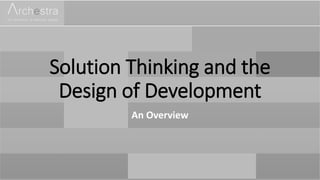
Solution Thinking and the Design of Development
- 1. Solution Thinking and the Design of Development An Overview
- 2. Solution Thinking and Design For skilled and professional problem solvers, there has been a remedial expansion of the problem set that falls under the umbrella of “design” solutions. The expansion asserts that design is something that should be applied to a broader range of reasons why a problem is “important”. For example, aesthetics, economies, learning, ecology and other matters are all “valid” subjects for design. Part of seeing design as a more conceptually global practice has included some popularity of equating design with problem solving. In that sense, it is equated with solution development and, furthermore, is sometimes positioned as essential to problem solving where complexity is a challenge to gaining a necessary and sufficient outcome. In that attitude, designers who solve problems are looked at for their methods of solving, particularly the “thought processes” involved. In that way, even the layperson can appreciate the implications of looking for “design thinking”.
- 3. The design of Development However, maintaining some distance from the cache of the Design Thinking term and its related vocabulary is not a bad idea. In a different perspective, designers (and however they think) are participating in development of solutions; that is, they are participating in Solution Thinking. A “solution” to a problem is normally an acceptable outcome of intentionally developing a future state. However, there are such things as unintentional solutions. The thinking that supports successful development is the essence of purposeful “Solving”. The primary contribution of Design to solutions is in the managed intentionality of the development to produce an accepted outcome. While we can see design as a set of influences on the terms of acceptability used in development, the progression from problem to solution is per se Solution Thinking. We can certainly consider “the Design process” as a process of arriving at the terms of acceptability used during development. However, we can argue quite strongly that the work of progressing the solution from a state of need to a state of agreeable usage is development. Development uses design as part of Solution Thinking. In the following, that idea is described on its own terms.
- 4. EXPLORATION EXPECTATIONMODELINGEXPERIMENTATION • Observed similar phenomena • Isolated or targeted occurrence • Characteristics of the anticipated situation with which the solution effort must contend • Created examples explicitly representing qualifications preferred for the solution • Final decision agreed as the next selected current state Meaning: Cases Instances Circumstances Proofs Acceptance PRESUMPTIONS REALIZATIONSPROPOSITIONSASSUMPTIONSAcknowledge current state Develop future state Variables: With or without coordination, some or all of the above can exist simultaneously. ©2016 Malcolm Ryder / Archestra Research
- 5. EXPLORATION EXPECTATIONMODELINGEXPERIMENTATION • Histories • Precedents • Conditions • Concerns • Ideas • Requirement (why) • Scope (where) • Definition (what) • Delivery (how) • Adoption (who) • Priorities • Purposes • Forms • Production • Testing • Constraints • Concepts • Techniques • Prototypes • Demonstrations Research (Intelligence) Provision (Value)Configuration (Options)Analysis (Prospects) Cases Instances Circumstances Proofs Acceptance PRESUMPTIONS REALIZATIONSPROPOSITIONSASSUMPTIONSAcknowledge current state Develop future state Influence or feedback Influence or feedback Influence or feedback How: Maturation towards acceptance ©2016 Malcolm Ryder / Archestra Research
- 6. Developing the future state Progress occurs within a stage, but also across stages in an upward spiral of maturing satisfaction, towards final acceptability. Each of the four upward stages has its own way of revisiting the same five issues: • Cases • Instances • Circumstances • Proofs • Acceptance Each stage seeks clarity and agreement about each issue. ©2016 Malcolm Ryder / Archestra Research
- 7. EXPLORATION EXPECTATION MODELING EXPERIMENTATION Develop the future state: Each of the four stages has its own way of addressing the same five issues: • Cases • Instances • Circumstances • Proofs • Acceptance The way an issue shapes up in a later stage of maturation can feedback to that same issue in an earlier stage. Desired Intelligence Desired Impacts Desired Options Desired Prospects ©2016 Malcolm Ryder / Archestra Research
- 8. THESE CAN COME INDEPENDENTLY OF EACH OTHER, FROM DIFFERENT SOURCES AND TIMES. EXPLORATION EXPECTATIONMODELINGEXPERIMENTATION Research (Intelligence) Provision (Value) Configuration (Options) Analysis (Prospects) Develop future state Influence or feedback Influence or feedback Influence or feedback Using… With alignments… SOLVING: acceptance cases proofs instances circumstances ideas histories concerns precedents conditions demos constraints prototypes concepts techniques testing priorities production purposes forms adoption requirement delivery scope definition ©2016 Malcolm Ryder / Archestra Research
- 9. EXPLORATION EXPECTATION MODELING EXPERIMENTATION Research Provision Configuration Analysis Intelligence Value Options Prospects What is being done What is being developed SOLUTION DEVELOPMENT Awareness Impact Confidence Preference Milestone* achieved * Milestone failures cause solution efforts to be rejected.©2016 Malcolm Ryder / Archestra Research
- 10. Archestra notebooks compile and organize decades of in-the-field empirical findings. The notes offer explanations of why things did happen or can happen in certain ways or to certain effects. The descriptions are determined mainly from the perspective of strategy and architecture. They comment on, and navigate between, the motives and potentials that predetermine the decisions and shapes of activity as discussed in the notes. All notebooks are subject to change. ©2016 Malcolm Ryder / Archestra Research
- 11. ©2016 Malcolm Ryder / Archestra Research www.archestra.com mryder@archestra.com
